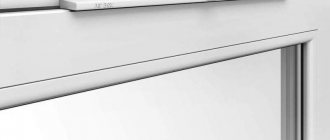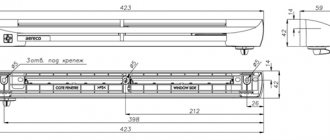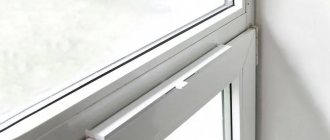13.10.2021
Since plastic windows began to be installed everywhere, apartments have become much warmer and quieter. This is due to the tightness of the design of modern windows.
However, a lack of air flow leads to stuffiness, poor sleep and headaches in the morning, as well as fogging of windows, the appearance of fungus and a general deterioration of the microclimate in the house. Moreover, even if the house has a hood, the lack of fresh air will cause all of the above problems.
To avoid deterioration of well-being and microclimate, it is necessary to ensure adequate air supply . This can be done in different ways, and installing a supply valve is perhaps the simplest and cheapest of them.
By installing a supply valve in the wall, you can avoid stuffiness, condensation, get rid of fungus, and also prevent the appearance of dust and dirt that enters the apartment as a result of regular ventilation. However, there are many types of supply valves, and it is necessary to select a model in accordance with the installation conditions. Read to the end and you will learn how to choose a supply ventilation valve.
Why do you need a supply valve?
Previously, windows were made of wood, and the gaps between the glass and the frame were practically not sealed. Therefore, there was always fresh air entering the room naturally through small gaps in the window frames.
Plastic windows, unlike wooden ones, are completely sealed and air cannot pass through them freely.
Due to the lack of oxygen flow, natural ventilation is disrupted, as a result of which apartment owners may encounter the following problems:
- The carbon dioxide content increases. High concentrations of carbon dioxide cause drowsiness, headaches, irritability and loss of performance.
- The room starts to smell bad. If there is no hood, unpleasant odors linger in the apartment, creating an extremely uncomfortable atmosphere.
Solving the ventilation problem is quite simple - you need to ensure a flow of fresh air.
For this purpose, you can install a full-fledged ventilation system, which, by the way, is quite expensive, or you can use a supply and exhaust valve.
The supply valve is inexpensive and can be installed quickly. A supply valve is mounted in the wall, allowing you to control the rate of air flow from the street.
Some tips
- The installed device must be cleaned periodically. It is especially important to do this for owners of city apartments, where soot and dirt from the street will inevitably settle on the filter of the device.
- Ventilation operation must be checked regularly. For this purpose, you can use a candle flame or paper cut into thin strips.
Example of a supply circulation device
Design and principle of operation
Before purchasing a fresh air ventilation valve, you need to understand what it consists of and how it works. There are models of different designs, each of which has its own characteristics and is intended for certain conditions.
Externally, the valve is a cylinder equipped with filtration and noise reduction systems. The main elements of the device are:
- Air duct. Inserted into a hole in the wall. A plastic pipe with a diameter of 6 to 14 cm, through which air from the street enters the apartment. The larger the diameter of the duct, the greater the volume of supplied air.
- External grille. May vary in appearance and function. In inexpensive valves, the grille protects against large debris and other large particles. More advanced models are equipped with mosquito nets and also have protection from precipitation. Grilles are also made of plastic or metal.
- Header. Allows you to adjust the flow rate. Located inside the apartment. Location and configuration may vary.
- Heat and sound insulation. To prevent the wall from freezing in winter, insulating material, usually in the shape of a sleeve, is laid along the entire length of the air duct.
- Internal filter. Located closer to the inside of the device. It is made from different materials, depending on the model, and retains exceptionally large dust and dirt.
Separately, we can note such a basic functional element as the damper. It can regulate the flow rate or completely close the hole, no air will get in. Thus, regardless of weather conditions, a comfortable microclimate is always maintained in the room.
The supply valve works as follows:
- Air enters the valve cavity through the street grille.
- Inside the valve, the air is slightly warmed up due to the heat from the wall as it passes inside the duct.
- The filter removes dirt, dust and pollen.
- The flow intensity can be changed using the internal damper.
The advantage of the valve is that fresh air flows continuously. For ventilation, there is no need to open windows through which dust and noise can enter.
It is important to understand that by installing a supply valve into an apartment, you will not solve all ventilation problems. If the room does not have a full exhaust hood, air exchange will be ineffective.
In other words, if you plan to install all the ventilation elements yourself, we recommend that you study this issue thoroughly beforehand.
What would I do differently now if I were starting from scratch?
- I would check the ventilation operation using a device for measuring pm2.5 immediately at the manufacturer’s demo stand.
- I would check the design of the housing and filter unit at the demo stand to see if there are any cracks there.
- I wouldn't contact Minibox. It's not even about air leaks, but about the approach to solving my problem.
- I would not install a ready-made system with a HEPA filter, but a separate ventilation unit and a separate filter unit. I would look first of all for ventilation from Turkov: there were excellent reviews about them. Filter blocks - for example, this one or this one.
- I would install a system with an air exchange of 600 m3/h so that it would be even quieter than my current one at 350 m3/h, for example, Turkov Capsule 600. The difference in price from 350 m3/h is small.
- I would not buy the Air Quality Pollution Monitor. I would only buy AirVisual Pro.
- Perhaps I would install a breather instead of an inlet: it’s cheaper and simpler. As an option, Tion with a silencer. Or I would look at breathers that can be quieter than Tion, for example, a breather from Xiaomi. For a room that does not border a balcony, I consider this as the main option.
- I would be prepared for the fact that ventilation in an apartment is largely an accident. You don’t know in advance at what speed the ventilation or breather will need to be set for your room. Therefore, you don’t know the noise level in advance, even if you go to listen.
- I would take a closer look at systems with recuperation to save on electricity bills and maintain humidity. In November-December, I spent 1,500 rubles on electricity to heat the air in the ventilation. Initially, I rejected recovery, thinking that by law it could not be done in apartment buildings. But it seems I was wrong.
- I would glue everything not with ordinary tape, but with aluminum or reinforced tape. In the comments and on the ixbt forum it was indicated that this is better, and aluminum tape is usually used in ventilation.
Types of supply valves
There are several types of supply valves, differing in design and, accordingly, functionality. Window devices and wall valves with variable flow rates stand out.
When choosing a valve, you need to understand all the functional features of the devices offered on the market. Thus, you can purchase a supply valve that fully corresponds to the conditions in which it is intended to be used. Otherwise, ventilation will not work effectively.
KIV (air infiltration valve)
A simple and effective device designed for wall installation. Used in rooms with normal exhaust hood. It is a plastic pipe with a diameter of about 125 mm and a length of 0.5 or 1 meter. During installation, the length is cut according to the thickness of the wall.
On the outside, the pipe is covered with a metal grille with a mosquito net, and on the inside, a plastic cap with a filter inside is installed. The flow rate is controlled by a damper. The inside of the pipe is insulated to prevent the walls from freezing.
Features of KIV:
- Can be installed at any stage of construction. Including after renovation.
- Does not degrade the appearance of the walls.
- No windows are needed for installation.
- Suitable for installation in any part of the wall.
- In winter, condensation does not form on structural elements.
Another significant advantage of the KIV is that it can be quickly replaced with a valve with forced air supply.
Ventilation control
The ventilation clinker can have automatic or manual opening mode. In the latter case, the user, by changing the position of the curtain, independently achieves stabilization of the flow of air masses. He also monitors the duration of ventilation (if neglected, it is quite possible for the room to freeze out).
In the automatic mode of opening the curtains, action is possible according to two schemes:
- The adjustment of the curtain position is determined by a polyamide sensor - in conditions of high humidity the flow area increases, and in conditions of low humidity it decreases;
- The air supply level is set based on the difference in pressure inside and outside the room, while the opening range of the curtain is determined by the user.
With all the advantages of smart automatic flow valves, they often simply do not have the function of completely blocking ventilation. Moreover, their prices are far from low.
Supply ventilation OXY1
OXY1 is the “junior” model from the OXY series of supply ventilation units. In fact, it is a supply valve with a compact (246×326×125 mm) internal block. It operates in “passive” mode, providing fresh air without using a fan or consuming electricity. Exclusively presented in the company AEROS.
Where can it be used? Supply ventilation OXY1 is suitable for small spaces (apartment or office).
What capabilities does it have? The device organizes air exchange and provides air purification (a class F5 filter is installed). The productivity of the device is 60 m3/hour, which covers the need for air exchange volumes when 1-2 people live in a room.
What advantages does it have?
- fresh air 24/7 with the windows closed (no drafts, dirt on the windows and street noise);
- cleaning the air from dust, fluff and small debris;
- low price (from 3990 rubles);
- installation can be carried out immediately on site, for final repairs, in just 1 hour;
- compact dimensions (slightly larger than a standard sheet of A4 paper);
- complete absence of noise during operation;
- Upgrade to a full-fledged breather is possible (models OXY2 and OXY3).
Supply valve VAKIO KIV
Just like the KIV, the supply and exhaust system implies the presence of both an exhaust hood and a supply valve. As a rule, the hood is equipped by the developer. On the other hand, if there is no natural exhaust, when installing a supply valve, a separate air exhaust system is also installed.
Let's consider one of the most functional models of supply valves VAKIO and its advantages:
- Low cost. VAKIO devices are among the most inexpensive.
- Quick installation. Typically installation takes 1 hour. Of course, installation conditions depend on the characteristics of the object, but in most cases installation proceeds quickly.
- Fire safety. The valve operates on 12 volts, which reduces the risk of fire.
- High purification, unlike KIV. Doesn't freeze.
- The VAKIO valve is the basic model of the device. To turn the valve into a recuperator, you need to upgrade and add a fan unit to the valve. This can be done at the AEROS company . For consultation, contact our professionals.
Selection Criteria
When choosing a valve for window structures, you need to pay attention to a number of important parameters:
- Product design, installation type.
- Presence of a protective canopy on the facade.
- Product performance.
- Valve noise insulation in dB.
- Installation dimensions.
- The need for profile milling.
- Material of manufacture.
- Exterior panel shade.
- Type of adjustment.
- The presence of a humidity sensor.
- Brand, country of production, what determines the retail price.
One of the main selection criteria is the presence of positive reviews about the brand’s products online, which indicates the high quality of the goods.
CONSULTATION WITH A SPECIALIST
CALL US 8 (495) 185-02-02
All supply systems are required to be equipped with filter elements, ensuring not only air supply, but also air purification. In cities with a high degree of pollution, this factor is of no small importance.
Inexpensive models purify the air from large dirt and dust, and more complex devices, in addition to large particles, also filter out pollen, viruses and other allergens - for example, car exhaust fumes. Thus, by installing a fresh air ventilation valve in a wall or window, you will not only provide your home with fresh air, but also protect yourself and your loved ones from irritable reactions resulting from the presence of contaminants in the air.
How to check the hood
In order for the supply valve to fully perform its function, the hood must be working in the room. If it is not there, there will simply be no room for fresh air, and the valve will not be able to work effectively.
Therefore, before installing the supply valve, you need to make sure that the hood is working properly. There are several simple ways to do this:
- Cut a strip of paper and hold it near the exhaust vent. Open the window and lean the paper against it. If the paper “does not move” or makes weak vibrations, then the hood is not working well.
- The presence of condensation on windows and cold areas of walls also indicates poor-quality operation of the hood.
- Check with an anemometer. The device is placed in the ventilation duct and the air flow rate is recorded.
It should be taken into account that if there is a large temperature difference between the room and the street, the hood works more efficiently. When the temperature equalizes, the speed of air movement decreases, which is why the hood begins to cope with its task worse. Therefore, if the weather is warm most of the year, it is wiser to choose a valve with forced air supply.
Principle of operation
This element functions as follows:
- Air enters the telescopic opening;
- Purified from some harmful elements;
- Penetrates indoors.
During this process, excess carbon dioxide is squeezed out. This happens due to the difference in pressure, since cold air enters and warm air is expelled (the recommended temperature value is no more than 5 degrees Celsius). If you violate the indicator, no difference will occur, and the device will be ineffective. Therefore, if a person lives in warm areas, then there is no need for this device, since it is easier to ventilate the premises manually. There will be heat loss, but not as critical as in cold weather.
How to choose a supply valve
There are many types of air supply systems, varying in size, main functions and performance. The choice largely depends on the operating conditions. In order not to make a mistake, we recommend consulting with professionals - experienced specialists are available in any serious company that sells ventilation equipment.
When choosing a valve for your home yourself, consider the following factors:
- Performance. This parameter indicates the throughput of the device. That is, you will know whether there is enough air for the people who live or work in the room.
- The temperature at which the device is expected to operate. For example, valves with a metal uninsulated channel are not recommended for use in cold climates - the walls will freeze. In regions with harsh winters, it is necessary to use plastic devices with additional insulation.
- Adjustment options. The setting can be either automatic or mechanical. Functionality depends on the valve model. Compared to mechanical control, automatic control allows you to create more comfortable conditions in the room, since air is supplied and heated depending on temperature changes and exhaust capabilities.
- Level of cleaning and the ability to improve the device if necessary.
Having taken into account the listed factors, you can easily select the most suitable valve that will provide your home with fresh, clean air at any time of the year and regardless of the presence of pollution.
Brief overview of the best manufacturers
When choosing a ventilator, users rely on different criteria. One of the important indicators of the duration and quality of operation of a supply valve is its manufacturer.
But sometimes the characteristics indicated in the product passport do not correspond to reality. To avoid such a situation, you should choose valves from well-known brands with a good reputation.
By choosing a supply valve from a well-known world brand that produces a wide range of ventilation equipment that has received recognition from millions of users, you can be confident in the reliability and practicality of the product
Next, we will briefly consider the best brands whose products are represented on the domestic market.
Vents automatic supply valves are considered the most popular solutions. Vents is a Ukrainian company that has won recognition from European users. Today, the manufacturer’s assortment includes more than 10,000 items.
Ventec is a Russian enterprise that produces aspiration and ventilation systems, specializing in the production of metal frame and cabinet products. The company has an excellent level of service.
Ballu brand supply valves are supplied to 30 countries. Ballu is a manufacturer specializing in engineering systems and climate control equipment. Having its own laboratories allows the company to use innovative solutions in production.
Tion is a Russian brand that is rapidly gaining popularity. ventilation, develops devices for highly efficient filtration and disinfection.










